Let me guess: You want your social media marketing (SMM) campaigns to run smoother than a Robert Downey Jr. one-liner, don’t you?
I don’t blame you.
When you consider how crucial social media marketing is to the success of any business, it’s understandable that you want your campaign to be as slick as it can be.
The sad part is, the reality of your SMM campaigns isn’t at all sunshine and rainbows, is it?
In fact, if you’re reading this guide, then I’m guessing your campaigns are most likely a little bit all over the place.
If you resemble this remark—or what I’ve said so far strikes a chord and you’re considering calling it quits because of how chaotic your social media marketing campaigns are, then allow me to share with you these five tips that can help streamline your process so you can get better results out of your social media marketing efforts.
1. Set your goals
Because your goals are the guiding compass to your campaigns, it’s crucial for you to define them clearly before you start. Whether you’re publishing a new post, running a new social media contest, or putting together a new social media ad, ask yourself first if doing so will bring you closer to the goals you’ve set.
If the answer is “No”, you probably shouldn’t bother doing that.
It’s also worth pointing out that your goals don’t always have to be sales. In some cases, you need to “warm” your audience first up, before you start directing them to your sales page. Providing value to grow your audience and establish yourself as a thought leader or subject matter expert is also worthwhile. In fact, the better you do that, the more effective you will be when you want to convert that audience into sales.
You should also do some research to determine the size of the potential audience on the social media platform you intend to use. Make sure that you can get your message in front of people likely to be interested in your product or service.
Here’s an example. If you’re planning to use Facebook as your primary social media platform for marketing your business, you can use their Audience Insights tool to look into the groups or demographics that are pertinent to your niche.
I used “Truck drivers” as my sample audience. This is what Facebook came back with.
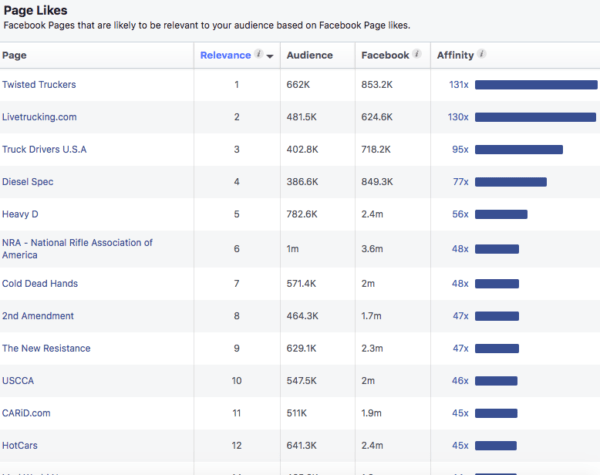
Granted, some of these groups might not be directly relevant to truck drivers, but the insights you can obtain can still give you a decent idea of how large (or small) your audience might be.
Note: I could keep scrolling all the way down, by the way. Not only that, I obtained that info just from one keyword. If we experimented on several more, we are bound to see more groups or communities that might be relevant to truck drivers.
While there are a plethora of metrics or goals you can set, these are some of the most commonly used by social media marketers:
- Leads/Signups
- Engagement
- Brand awareness
- Website traffic
- Sales/Revenue
- Community growth
2. Use a reliable social media marketing tool
Now that you’ve clearly identified your goals, it’s time to determine the tools you’ll need to get the job done.
Remember, even the greatest marketers in the world rely on the best tools in the market to remain competitive. The good news is, the best doesn’t always mean the most complicated or hardest to learn.
Most marketing software vendors today prioritize usability and functionality above all—empowering even one-man teams to accomplish their objectives in a fast and cost-effective manner.
For example, Keyhole is a simple yet robust social media listening tool that will enable you to be in-tune with your target audience.
Keyhole is primarily a tool that can help you track keywords and hashtags that are relevant in your niche. Within a few clicks, you can have eyes and ears across the social media sphere.
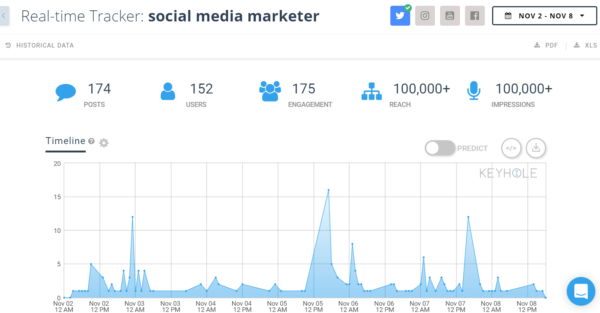
Another useful feature of Keyhole is the “Web Mentions” tool. As the name suggests, this allows you to find posts that mention your brand—giving you the opportunity to connect with prospective leads, clarify any misinformation, provide assistance, or extract feedback from your audience.

In some cases, tracking brand mentions on social media will help you find potential influencers who could be interested in promoting your brand. These are popular bloggers, social media users, YouTube creators, and other high-profile individuals with an established following.
Of course, you can also create a Keyhole tracker that monitors the social media activities and gauge the reach of these influencers. Simply select “@Accounts” on the “Create New Tracker” page and enter the name of the influencer you want to track.
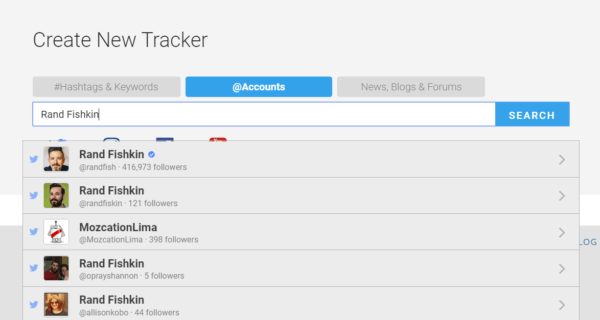
3. Use a team collaboration and communication tool
Although solopreneurs can pull off successful social media marketing campaigns, that doesn’t mean they should forego the value of working with a competent team.
Keep in mind that the manpower you need to fill skill and knowledge gaps in your business can easily be found through freelancing marketplaces, including Upwork and Freelancer. Once you’ve put together a team of rockstar freelancers, the only thing you need is a team collaboration platform that will help you and your freelancers stay on the same page.
ClickMeeting is one of the most comprehensive platforms you can use for this purpose. Its core selling point is the extremely handy webinar creation tool, which lets you utilize the power of live video to foster a more tightly-knit team.
During a live webinar, viewers can use the “chat pod” to make inquiries, share feedback, or respond to questions asked by the presenter. You can also use the desktop sharing and virtual whiteboard tools to communicate with your team more effectively.
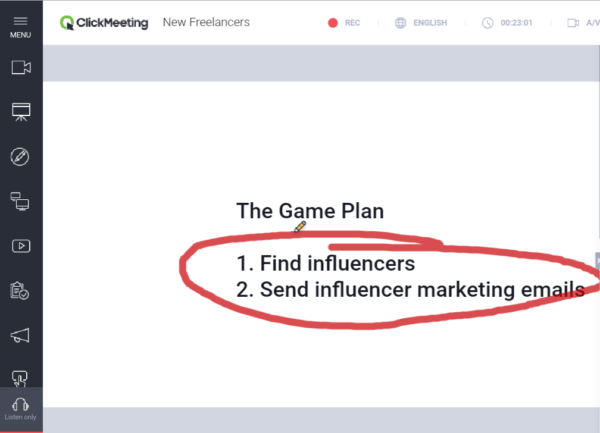
A great way to use ClickMeeting to create resources you can use over and over again to onboard new team members is to create on-demand webinars. These are pre-recorded webinars you can use to brief your new team members or structure an elaborate onboarding program.
To create an on-demand webinar, start by creating a new live event. Just fill in the necessary information on the configuration page and set “Permanent event” as your room type.
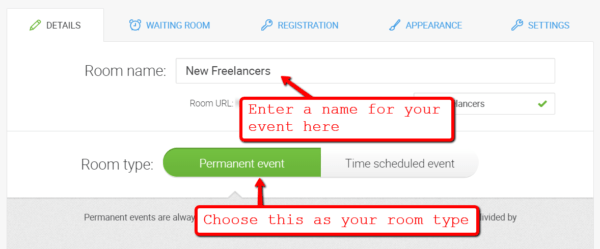
The next step involves inviting participants to your webinar, be it your prospective freelancers or co-presenters. ClickMeeting will walk you through the steps of handing out the invitations — from specifying your contacts to choosing an email template.
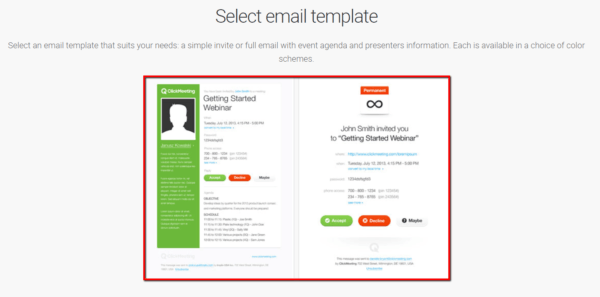
Once the invitations are out, ClickMeeting will open your webinar room in a separate window. Go ahead and click the record button from the top toolbar, select a webinar layout, and click “Start recording.”
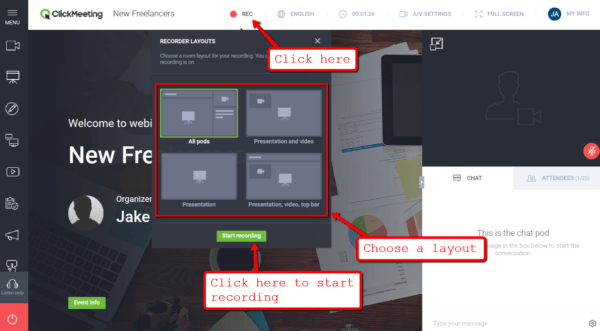
Finally, you can give users on-demand access to your webinar by publishing your recording. To do this, head back to the ClickMeeting dashboard, navigate to the “Storage” tab, and select “Recordings.”
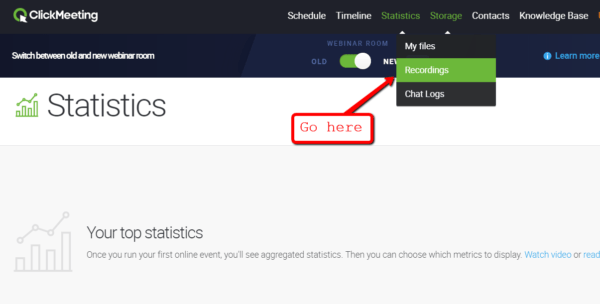
After you find the recording you want to publish, simply expand the drop-down “Actions” menu and click “Publish.” This will display the complete URL to your webinar along with quick share buttons on Facebook.
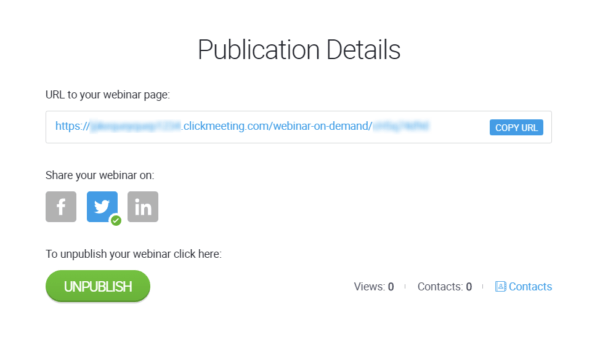
Of course, you can also create an on-demand webinar to spice up your lead generation and influencer marketing campaigns. All you need is a little creativity!
4. Run a social media audit
While there are several ways to do a social media audit, here’s a general direction you can follow:
- Gather all your social media profiles.
- Ensure that each of your profiles aligns with your brand image and overall message. In this section, you need to make sure your profile images, “About” sections, contact info, and links (among other things) are consistent.
- Take note of the goals that you sought to accomplish when you set up your campaigns.
- Peg the existing results that you garnered against the goals that you set. This often entails you tracking the posts that you published (paid or not) when you ran your campaign to see what kind of engagements or conversions you gained.
- There are only two possible results: you hit your goals, or you fell short. Regardless of what the results might be, look for common traits of high-performing or under-performing content.
Look for the common elements that your high-performing posts have and try incorporating them in your future campaigns while avoiding the common elements of your poor-performing posts.
- Determine which platforms and methods brought you the most favorable results.
- Orient the team about which platforms you’ll be using moving forward and share access to each platform to pertinent team members.
Remember that your audit can be as elaborate or as simple as you wish. If you have any questions or some different tips or tools you prefer for managing social media marketing campaigns, please share them in the comments below.
- Why Data Security Is the Real AI Risk - June 30, 2025
- Why Being Bold Matters in Cybersecurity—and Branding - June 3, 2025
- Gear Tested and Approved: My Top Picks for Dads and Grads This Season - May 28, 2025




Comments are closed.